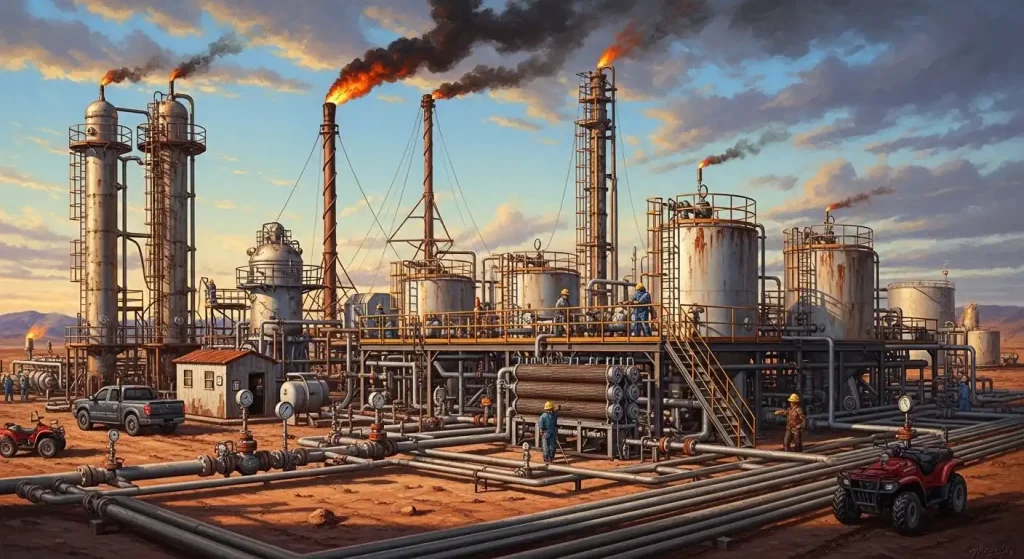
## From Blueprint to Burner: Fabricating Heater Treaters for the Oil and Gas Industry
Heater treaters are essential pieces of equipment in the oil and gas industry, playing a crucial role in separating crude oil, water, and natural gas. These vessels, often resembling large horizontal tanks, rely on heat to break down emulsions and facilitate the separation process. But behind their seemingly simple function lies a complex fabrication process requiring precision, expertise, and adherence to stringent industry standards. This article delves into the intricacies of fabricating heater treaters, highlighting the key steps, challenges, and considerations involved.
**The Journey Begins: Design and Engineering**
The fabrication journey starts long before any metal is cut. The design and engineering phase is critical, determining the heater treater’s specifications based on the specific well conditions and the fluids it will process. This involves:
* **Fluid Analysis:** Understanding the composition, viscosity, and emulsification tendencies of the incoming fluid is paramount.
* **Sizing and Capacity Calculation:** Determining the appropriate vessel size, heating capacity, and retention time to achieve optimal separation efficiency.
* **Material Selection:** Choosing materials that can withstand the operating pressures, temperatures, and corrosive nature of the fluids. Carbon steel is commonly used, but alloy steels or stainless steel may be required for more aggressive environments.
* **Process Design:** Defining the internal configuration of the vessel, including baffles, weirs, firetubes, and separation sections, to optimize fluid flow and separation.
* **Regulatory Compliance:** Ensuring the design adheres to relevant industry codes and standards, such as ASME Section VIII Division 1 for pressure vessels and API 12J for heater treaters.
**Fabrication: A Symphony of Skills and Precision**
Once the design is finalized, the fabrication process begins. This involves a series of meticulous steps, each requiring specialized skills and equipment:
* **Material Preparation:** Steel plates and other components are cut to size and shape using plasma cutters, laser cutters, or traditional flame cutting techniques. Edges are beveled for welding.
* **Shell Assembly:** The vessel shell is formed by rolling steel plates into cylindrical sections and welding them together. This requires precise alignment and welding techniques to ensure structural integrity.
* **Head Fabrication:** The dished heads of the heater treater are formed using hydraulic presses and specialized dies. These heads are then welded to the shell.
* **Internal Component Installation:** Baffles, weirs, firetubes, and other internal components are fabricated and meticulously installed within the vessel according to the design specifications. This requires careful positioning and welding to ensure proper functionality.
* **Welding and Inspection:** Welding is a critical aspect of heater treater fabrication. Qualified welders using appropriate welding procedures are essential. Each weld undergoes rigorous inspection, including visual inspection, radiographic testing (X-ray), ultrasonic testing, and magnetic particle testing, to ensure soundness and prevent leaks.
* **Nozzle and Fitting Installation:** Nozzles, manways, and other fittings are welded onto the vessel to provide access for fluid inlet, outlet, instrumentation, and maintenance.
* **Hydrostatic Testing:** The completed vessel undergoes hydrostatic testing, where it is filled with water and pressurized to a level exceeding its design pressure. This test verifies the vessel’s integrity and identifies any potential leaks.
* **Surface Preparation and Coating:** The exterior of the heater treater is prepared for coating by sandblasting or other methods to remove rust and contaminants. A protective coating is then applied to prevent corrosion and extend the vessel’s lifespan.
* **Instrumentation and Control Installation:** Instruments such as pressure gauges, temperature sensors, level controllers, and safety devices are installed and calibrated to ensure proper operation and safety.
* **Skid Mounting (Optional):** For ease of transportation and installation, the heater treater can be mounted on a skid, along with associated piping, instrumentation, and control panels.
**Challenges and Considerations**
Fabricating heater treaters presents several challenges:
* **High Pressure and Temperature Requirements:** The vessels must withstand high operating pressures and temperatures, demanding robust designs and high-quality materials and fabrication techniques.
* **Corrosion Resistance:** The corrosive nature of the fluids being processed requires careful material selection and the application of protective coatings to prevent degradation of the vessel.
* **Tight Tolerances:** Precise fabrication is essential to ensure proper fit-up, welding quality, and overall structural integrity.
* **Stringent Quality Control:** Rigorous quality control measures are necessary throughout the fabrication process to ensure compliance with industry standards and prevent defects.
* **Skilled Labor:** The fabrication process requires highly skilled welders, fitters, and other craftsmen with expertise in pressure vessel fabrication.
**The Future of Heater Treater Fabrication**
The future of heater treater fabrication is likely to see advancements in:
* **Automated Welding:** Robotic welding systems can improve welding speed, consistency, and quality, reducing labor costs and improving overall efficiency.
* **Advanced Materials:** The development of new and improved materials with enhanced corrosion resistance and strength can extend the lifespan of heater treaters and reduce maintenance requirements.
* **Digitalization and Data Analytics:** Utilizing data analytics to monitor the fabrication process and predict potential issues can improve quality control and prevent costly errors.
* **Modular Construction:** Fabricating heater treaters in modular sections can facilitate transportation and installation, especially in remote locations.
**Conclusion**
The fabrication of heater treaters is a complex and demanding process that requires a combination of engineering expertise, skilled craftsmanship, and rigorous quality control. By adhering to stringent industry standards and embracing technological advancements, manufacturers can ensure the reliable and efficient operation of these critical pieces of equipment, contributing to the safe and sustainable production of oil and gas. The journey from blueprint to burner is a testament to the ingenuity and dedication of the professionals who bring these essential vessels to life.